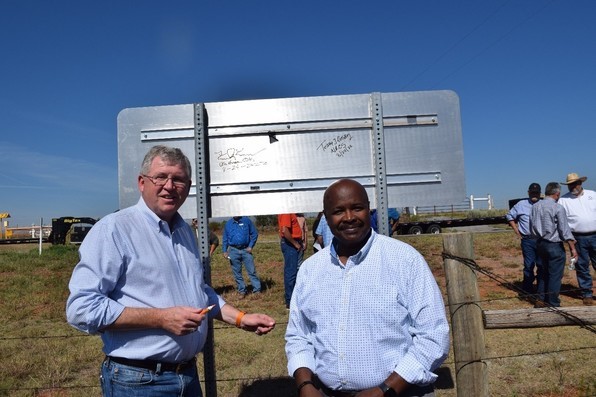Sign recognizes re-named flood control site: Sergeant Major Frank Lucas Dam
CHEYENNE, Okla. — What’s in a name?
In the case of the newly renamed Sergeant Major Frank Lucas Dam, the answer is a lot of years of tremendous support for Oklahoma’s upstream flood control dams. Oklahoma Conservation Commission Executive Director Trey Lam said, “Congressman Lucas was critical in creating the pilot rehab project and championing long-term funding for the small watershed program.”
Oklahoma leads the nation with 2,107 upstream flood controls dams, protecting lives and infrastructure across the state. Sergeant Major Frank Lucas Dam is located two miles south of Cheyenne, Okla., home of U.S. Congressman Frank Lucas, a champion of these dams for decades.
On Wednesday, a surprise special ceremony was held to reveal a sign renaming the Sergeant Major Creek Site 2 as “Sergeant Major Frank Lucas Dam.” Congressman Lucas was crucial in creating this pilot rehabilitation project and championing long-term funding for the small watershed program.
Lucas said, “I was taken by total surprise. It’s always a nice thing when your community, your neighbors you work with and try to help throughout a career recognize the conservation issues and that this represents the upstream flood control dam program, something we together created that didn’t exist before I was a member of Congress. The streamlining of the new construction monies means that the work of conservationists all the way back to the 1930s in Oklahoma and before, will continue. I think this is continuing the legacy of a lot of great Oklahomans trying to protect the environment and people.”

Lam added, “Throughout his career, ever since Congressman Lucas went to Congress in the mid-1990s, he’s been a supporter of agriculture and conservation in general, but specifically of the small watershed flood control program. It really had its origins right here in Roger Mills County, in fact the Hammon Flood (1934, killed 17 people) was on Sergeant Major Creek, and so as dams got to the end of their design life, he supported a bill to rehabilitate them, to extend that life another 100 years.”
This site is a high hazard flood control dam constructed in 1949 as part of the Washita River Flood Prevention Program. It is located in western Oklahoma’s Roger Mills County and the Upper Washita Conservation District is the local project sponsor and responsible for operation and maintenance.
In July 1998, the Natural Resources Conservation Service, authorized the Oklahoma NRCS to establish a pilot project on rehabilitation of aging watershed dams. Sergeant Major Creek Sites 1 and 2, the latter which was renamed, were selected for major rehabilitation, including replacing the concrete principal spillways and inlet towers, raising the height of the dams, and widening the auxiliary spillways.
In 2000, Site 2 was the first flood control dam in the nation to be rehabilitated. The dam was raised and the auxiliary spillway enlarged. The concrete tower and principal spillway have been replaced and a new drainage system installed in the back of the dam. The total cost of the rehabilitation was $431,822.
The rehabilitation of Sergeant Major Frank Lucas Dam insured that the dam continue to provide benefits for the next 100 years. The pilot project has served as a model for rehabilitation of hundreds of flood control dams across the nation.
Congressman Lucas introduced the legislation that became the Watershed Rehabilitation Amendments to the Watershed Protection and Flood Prevention Act (PL 83-566) that authorizes USDA Natural Resources Conservation Service to work with local watershed project sponsors to address public health and safety concerns and potential adverse environmental impacts of aging dams.
